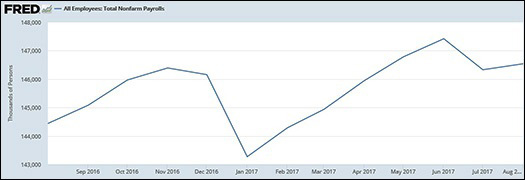By Pam Martens and Russ Martens: October 6, 2017
This morning’s September jobs data from the Bureau of Labor Statistics (BLS) does not actually capture the extent of the economic misery in the U.S. mainland last month. The data showed a stunning loss of 33,000 jobs (the first time the U.S. has had a negative figure since 2010) while simultaneously reporting that the unemployment rate dipped to 4.2 percent from 4.4 percent in August.
But here’s the quirky thing about how the U.S. government counts people as being employed: according to the official web site of the U.S. Department of Labor’s Bureau of Labor Statistics, an individual can be counted as employed even if they didn’t receive a dime in salary during the week the data is collected. The BLS explains its rationale as follows: (Italic emphasis added.)
People are considered employed if they did any work at all for pay or profit during the survey reference week. This includes all part-time and temporary work, as well as regular full-time, year-round employment. Individuals also are counted as employed if they have a job at which they did not work during the survey week, whether they were paid or not, because they were:
On vacation;
Ill;
Experiencing child care problems;
On maternity or paternity leave;
Taking care of some other family or personal obligation;
Involved in a labor dispute;
Prevented from working by bad weather.
The government counts these individuals as employed under the rationale that “they have a specific job to which they will return.” But in a labor market where workers are frequently paid on a per diem basis and live from paycheck to paycheck, what the government is reporting and the economic reality on the ground may be quite two different things.
There is another situation where an individual could not be receiving a dime of compensation – on a long term basis – but still counted as employed by the U.S. government. The BLS provides two examples:
Garrett is 16 years old, and he has no job from which he receives any pay or profit. However, Garrett does help with the regular chores around his parents’ farm and spends about 20 hours each week doing so.
Lisa spends most of her time taking care of her home and children, but she helps in her husband’s computer software business all day Friday and Saturday.
Both Garrett and Lisa are considered employed. They fall into a group called unpaid family workers, which includes any person who worked without pay for 15 hours or more per week in a business or farm operated by a family member with whom they live. Unpaid family workers comprise a small proportion of total employment. Most of the employed are either wage and salary workers (paid employees) or self-employed (working in their own business, profession, or farm).
Then there is the government’s casual reference to the fact that “People are considered employed if they did any work at all for pay or profit during the survey reference week.” Jim Clifton, Chairman and CEO of the polling organization, Gallup, addressed this issue in an article on the company’s web site in 2015. Clifton wrote:
“Say you’re an out-of-work engineer or healthcare worker or construction worker or retail manager: If you perform a minimum of one hour of work in a week and are paid at least $20 — maybe someone pays you to mow their lawn — you’re not officially counted as unemployed…”
The BLS released the following statement on the impact of Hurricanes Harvey and Irma on their data this morning.
“Hurricane Irma made landfall in Florida on September 10–during the reference period for both the establishment and household surveys–causing severe damage in Florida and other parts of the Southeast. Hurricane Harvey made landfall in Texas on August 25–prior to the September reference periods–resulting in severe damage in Texas and other areas of the Gulf Coast. Our analysis suggests that the net effect of these hurricanes was to reduce the estimate of total nonfarm payroll employment for September. There was no discernible effect on the national unemployment rate. No changes were made to either the establishment or household survey estimation procedures for the September figures. For both surveys, collection rates generally were within normal ranges, both nationally and in the affected states. In the establishment survey, employees who are not paid for the pay period that includes the 12th of the month are not counted as employed. In the household survey, persons with a job are counted as employed even if they miss work for the entire survey reference week (the week including the 12th of the month), regardless of whether or not they are paid. For both surveys, national estimates do not include Puerto Rico or the U.S. Virgin Islands.”


